Since the very beginning of computers, developing software required abilities to understand digital logic, mathematics, and at least one programming language for getting the work done. The more detailed understanding a person has about all these concepts, the easier it gets for them to create efficient and effective computer software, whereas having a limited understanding will make this very same task pretty difficult or almost impossible to achieve.
But now it is a story of the past. Because in today’s time there are massive changes in things. With the emergence of robust machinery, graphical user interfaces, as well as the supporting software programs, have empowered the low-code development effort in order to gain momentum, allow the users to design their websites as well as the complete system even if they possess basic knowledge of software engineering or computer science projects.
Low-Code development, in simple terms, means the development of a software program graphically with writing very little or almost no code while doing so. However, this is still different from no-code platforms. Here in this curated article, we will be encompassing all the nooks and corners of the Low-Code Development Platform that you should have an idea about.
What Exactly Is A Low-Code Development Platform?
Low-Code development platform basically is an all that offers the GUI (Graphical User Interface) for the purpose of programming, and thus the development of code becomes really fast, reducing the programming efforts of traditional time. With these tools, you can develop the codes really quickly by cutting down on the hand-coding efforts. The usefulness of these platforms is not limited to the coding but also spreads to deployment and quick setup.
The Development Of Low-Code
In order to find the resolution to a significant discrepancy, the developers have strived hard. On one side, the ambiguity and complexity that is deep-rooted and ingrained in the natural languages that are used by humans on a daily basis, and on the other side, we have the unforgiving and harsh logic of the programming languages.
A quick example of this is, consider the instruction on a shampoo bottle that says “Lather, Rinse And Repeat”. Wherein humans take its meaning to do the written process twice, a computer may get stuck into an infinite loop.
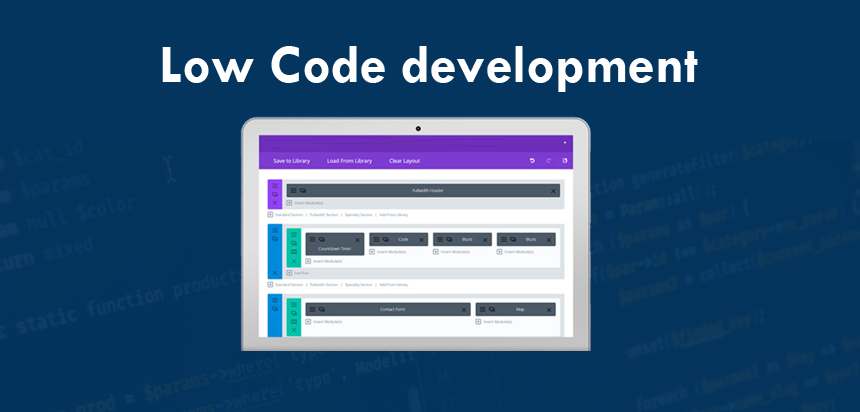
Developers spend a lot of their effort and time in order to mentally undertake the process of coding as well as debugging those codes line by line. Low Code development tools can be considered as an attempt for bridging this gap by allowing the users to think as well as a program in a way that can closely approach the way in which they do it in real life without the need of learning any syntax or the technicalities of that very language.
These tools are part of the 4th Gen of the program languages that represents the additional advancements they have over the third-gen languages. This is also inclusive of those languages specialized for a specific use case like mathematical optimization or database management and low-code development as well.
The emergence of the concept of low-code development can be located back to the year 2011. It all started with the publication of the report regarding new platforms for the productivity of the custom app development. But it was in the year 2014 when Forrester, a market research company, issued their report that described a new phenomenon and devised the terminology of low-code.
Around the same time, Gartner, an advisory and IT research firm, devised the term “citizen developer”. It is defined as the user who creates new business apps for the purpose of consumption by the others who use runtime and development environment as sanctioned by the corporate IT. To put it in simple terms, anyone building a business app for internal consumption even without being one amongst the developer team. Both these terms of low-code platforms, as well as citizen developers, are completely interlinked. The latter is completely dependent on the former for doing its job.
In today’s time, the acceptance of low-code development tools is growing pretty fast. If a report by OutSystems in the year 2019 is to be believed, then already 41 percent of the companies have already put low-code development platforms in to use. At the same time, there is another bunch of 10 percent of companies that are planning to deploy it in the future. With solutions like Oracle APEX and Microsoft Power Apps, even the significant-tech giants have jumped into the low-code space.
Low-Code Versus No-Code
The low-code and no-code development programs are often used interchangeably, though both of these are not the same thing. As the name itself suggests, the significant difference between both these platforms are:
→ The Low-Code development needs you to have basic coding skills so as to deploy an app successfully either with the help of full-fledged programmers or users themselves.
→ The No-Code development, on the other hand, is much more user-friendly and abstract in comparison to the low-code development. It provides a user experience that is completely based on visual development. This needs no knowledge about coding whatsoever. In order to successfully use the no-code tools, users need to be logical and should be someone who is capable of conceptualizing the app from the very beginning to the end.
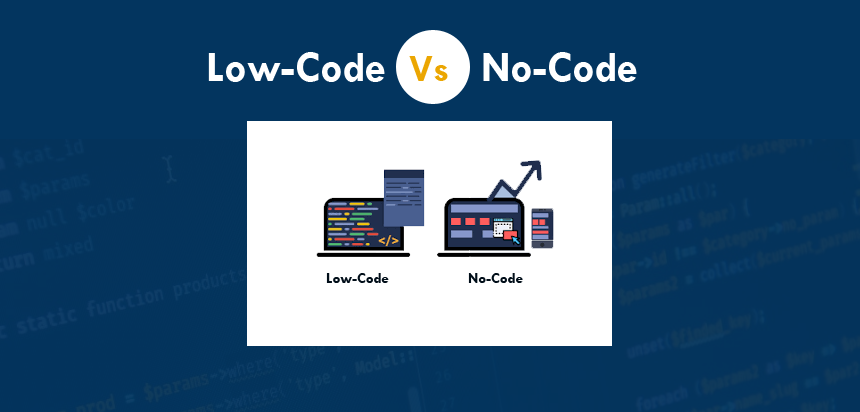
The major difference between the no-code and low-code is that the latter one is much more complex in comparison to the former one as it needs some level of programming knowledge. This difference has its own trade-offs. The no-code platform, on the one hand, is much more accessible to the wider audience level, whereas, on the other hand, the low code platforms are much more powerful that allows the users to hand-code a few parts of an app.
No-code tools are getting more and more popular and even much more preferred over low-code development in certain cases because they can both democratize as well as popularize the app development process of the entire organization. Low code no code are very similar terms.
Is Low-Code Development Platform Meant For You?
Now that we have an idea about what low-code development actually is, its history is, and the difference between both no-code as well as low-code. Let us talk about the benefits of the low-code development tools and how you can find out the best tool that can fit your organization well.
What Is It Like To Work With Low-Code Development?
Building software with the low-code is the same as building software in any other way. Unless you are someone who is writing everything from scratch in the machine code in which assembly language does not count, then, in that case, you are already taking the shortcuts that are built on the others’ work. Instead of hand-coding the other user management system and dealing with the peculiarity and the characteristics of the present-day programming frameworks or writing about 10 tests before you can write down a single line of the code of your application, you will get straight into the creation of something valuable and new. Basically, it cuts down the need to begin with something new when all these problems are already solved, and these patterns are already understood well.
Let’s compare creating an application using a common web framework for creating it using low-code.
The Advantages Of Low-Code Development
As stated by the CEO of OutSystems, Paulo Rosado, the low-code platforms might empower their users in delivering the apps at a speed about 10 times quicker than the traditional app development. Organizations in today’s time are adapting the new systems at their business speed. There are many significant benefits of low-code development:
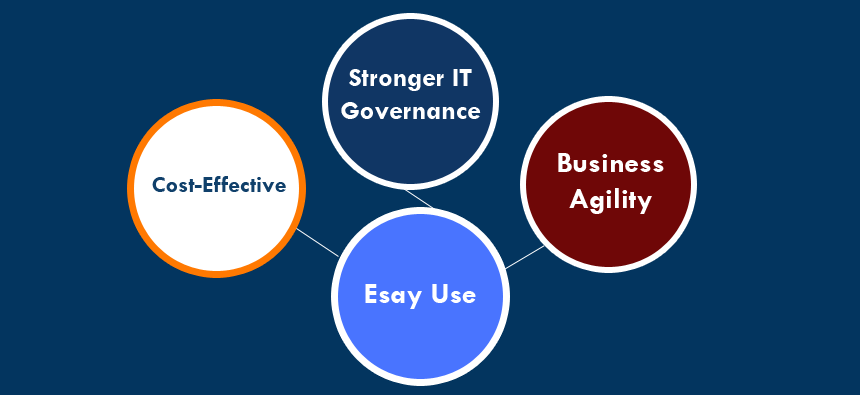
1. Cost-Effectiveness
The low-code development tools are more often than not pretty much cost-effective as compared to the alternative traditional app development for various reasons like:
- 1. There is no longer a need of hiring an in-house team for development purposes which proves to be a great point for organizations that do not have a specialty in app development.
- 2. When you have new employees that join your company, it is easier for them to learn the low-code development tools in comparison to the programming language they are unfamiliar with.
- 3. The development of apps is a lot more quickly with the low-code development tools as compared to the traditional development. The users of the apps will relish the benefits sooner, and the developers can then spend much more time on the productivity of the other tasks.
2. Ease Of Usage
As mentioned earlier, the low-code development tools are a lot more user-friendly and have a much simpler user-interface, and have a gentle learning curve when compared to traditional app development. For example, various low-code platforms both streamlines as well as unite the functions of various programs that are used by professional-level developers.
3. Business Agility
Owning to the ease of usage and the low costs, low-code development platforms have a ripple effect. This way, they improve the agility of the entire organization. The low-code developers shorten up the process of development, significantly rolling the new apps more quickly in the response to the changes in this business landscape that is evolving rapidly.
4. Stronger IT Governance
Shadow IT, the set of mobile apps, software, and hardware used by the employees without seeking permission from their respective IT departments is a significant issue faced by the organization that is looking forward to improving the IT governance. The origin of this lies in the dissatisfaction of the employees with their enterprise apps. With the low-code tools, users can make the process of app development into their own hands and build their software that can do the job while giving a lot more IT oversight and visibility.
Where Can Low-Code Tools Be Used?
All that being said, let us talk about all the places where these low-code app platforms can be used. The core theme of these app development platforms is nothing but digital transformation. Increase in the use of automation as well as improving the efficiency of the workflow of an organization with the help of business process management. No Code development cannot provide some of the low code capabilities.
One of the most famous use cases for low-code tools is the automatic generating connectors as well as application programming interfaces that can integrate two or even more enterprise applications. Traditionally, building the API from very scratch can be a lengthy and expensive process. An estimate made by DreamFactory states that it needs around $20,000 and 30 working days for building a basic API. Thus, by enabling the rapid app development that has a much shorter life cycle, the low-code tools can bring about a dramatic shrink in the timeline and thus bring about business transformation by helping the organization in saving money and also deploying the projects a lot quicker.
Mendix, the low-code platform vendor, has stated the four most notable low-code use cases.
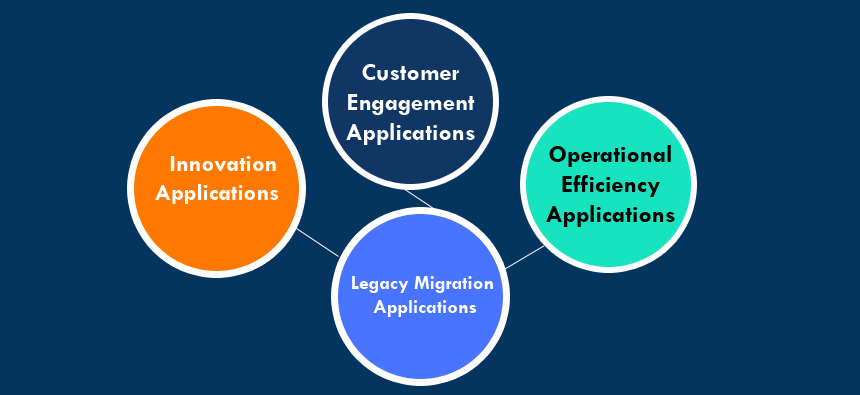
1. Innovation Applications
They take advantage of the latest channels, products, and technologies like the Internet of Things and Artificial Intelligence.
2. Customer Engagement Applications
So as to provide a better user experience to the customers, for example, the customer customer portals, web and mobile apps for claim management, etc.
3. Operational Efficiency Applications
In order to encode the business log for enacting the process automation, eliminating or reducing the manual paper-based process.
4. Legacy Migration Applications
For replacing the outdated, old apps that no longer suffice the user needs.
Top Platforms For Low-Code Development
1. OutSystems
OutSystems is basically a tailored solution when it comes to low-code development. This Rapid Application Development (RAD) platform is intended for the developers in order to create as well as manage the apps. It is super easy to both use as well as deploy.
Features Of OutSystems
- 1. Offers complete DevOps automation.
- 2. Provides full-stack visual development.
- 3. Gives native support for Agile development.
- 4. You can monitor things in real-time.
- 5. Offers in-app feedback as well as measurable architecture.
- 6. Offers deployment in a single click.
Rating
The general feeling about the platform is pretty positive and has a 4.5 stars rating with numerous reviews. It was impossible to get a one-star review.
Pros
- 1. Block-based coding makes debugging and writing a code easy.
- 2. You get to lay your hands on advanced-level enterprise features.
- 3. The templates that are offered make the process of application development quick.
- 4. The platform has documentation and training to offer.
- 5. You get versatile functionality integration.
- 6. It is also inclusive of the accelerators that are automatically generated in order to speed up the process of development.
Cons
- 1. You need to have some level of experience in coding.
- 2. You get less control over the infrastructure with their cloud-hosted option.
- 3 With the offline application, data synchronization can become difficult.
2. Xplenty
Xplenty is no-code and low-code ETL (extract, transfer, and load). This data integration platform is meant for both non-technical and small businesses as well as deeply technical engineers and developers. The platform lets its users build the data pipelines to and from 100 data destinations and sources pretty easily. The platform offers customization, versatility, and also pre-built integration in order to simplify the process of data transformation.
Features Of Xplenty
- 1. Has a drag-and-drop interface.
- 2. The platform offers code-free and powerful data transformations.
- 3. They have a 24/7 customer support team.
- 4. They have the ability of seamless data migration.
- 5. You get both low-code as well as no-code options.
- 6. The platform has a Rest API connector that can pull the data from any source that got Rest API.
- 7. It is scalable.
Rating
Xplenty is graded as the 2020’s best ETL tool that has a rating of 4.4 stars out of 5 on G2, a business software program review site.
Pros
- 1. The platform is pretty stable and does not require much maintenance.
- 2. It is pretty intuitive and easy in usage.
- 3. You can very well customize it.
- 4. It is amazing for the businesses that use salesforce.
- 5. The Rest API connector lets you integrate with many other solutions.
- 6. The pre-built integrations save a lot of your time.
Cons
- 1. It does not support the use cases of pure data replication.
- 2. If you are someone who does not have a coding background, then you might find the error messages to be somewhat confusing.
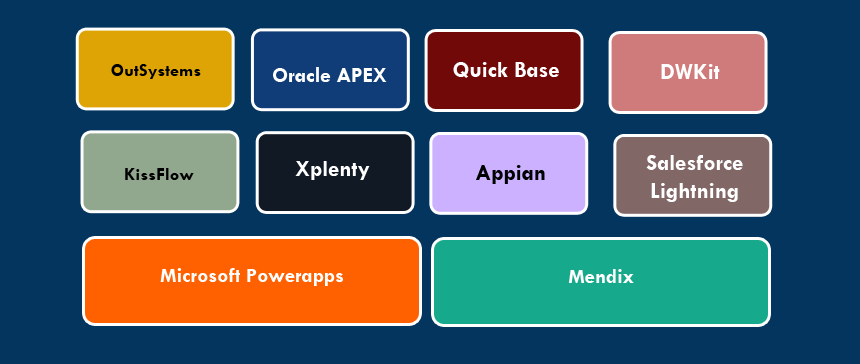
3. Oracle APEX
Oracle Application Express or Oracle APEX is a Rapid App Development platform with crucial features and incredible reviews. Moreover, Gartner has named Oracle as the Gartner Peer Insights Customer’s Choice for the Enterprise Low-Code Application platforms in November 2019.
Features Of Oracle APEX
- 1. The platform offers block-based coding.
- 2. It is used in the creation of secure enterprise applications.
- 3. The platform is pretty scalable.
- 4. You can deploy it anywhere.
- 5. Oracle APEX offers documentation, tutorials, humongous community resources as well as events.
Ratings
In general, the entire platform has excellent reviews and holds an average of 4.5 stars out of 5. Though it does not have many reviews, the rate of user satisfaction is about 90 percent.
Pros
- 1. The platform is highly customizable and easy in administering.
- 2. It is easy to test and offers page execution in just a single click.
- 3. Adding Oracle APEX is free for you if you already have the Oracle database.
Cons
- 1. It can get difficult to deploy with the on-site database.
- 2. You need some programming skills, especially in order to build complex applications.
4. Quick Base
The platform has proved itself to be one of the most beloved platforms for low-code development that widely uses database software and cloud-based RAD. Forrester recognizes it as the top-tier low-code tool.
Features Of Quick Base
- 1. The platform has end-to-end process automation.
- 2. There are multiple levels of payments and centralized data.
- 3. Quickbase is a holistic solution for various parts of the enterprise.
Ratings
The platform has a humongous amount of reviews, out of which most of them are positive ones. The average rating is 4.5 on 5 stars.
Pros
- 1. The data management is automated.
- 2. Works really fast and is an excellent CRM solution.
- 3. Offer live updates and excellent customer support.
Cons
- 1. Reviews suggest that the platform is not optimized for mobile.
- 2. It lacks customization options.
5. Appian
The platform is known for offering application development at 20 times faster speed as compared to hand-coding. Appian is a Business Process Management platform that is commonly used and provides numerous case studies in order to prove reliability.
Features Of Appian
- 1. The platform offers drag-and-drop coding.
- 2. It is super easy to share and is pretty secure.
Rating
The platform has an average of four stars out of 5 with several hundred reviews and is used by numerous significant companies.
Pros
- 1. It is super easy to debug and simple in customization.
- 2. The platform has an excellent user interface and offers updates in real-time.
Cons
- 1. The integration testing is tough.
- 2. It gets tough to adjust with the schedule of three-month upgrades.
6. KissFlow
KissFlow is a recognized leader in the space of the Digital Workforce Software at g2.com. The platform has a beautiful drag-and-drop interface for RAD, which is visually-pleasing.
Features Of KissFlow
- 1. The platform offers data synchronization and security.
- 2. You get mobile access and the option of drag-and-drop coding.
- 3. It provides great versatility and allows hand-coding too.
Rating
With hundreds of reviews, the average of the platform is 4.5 stars out of 5.
Pros
- 1. It is completely flexible and offers an incredible tracking feature.
- 2. You get access to complete ticket history.
- 3. It provides great value according to the price charged.
- 4. Cloud hosting makes internet access a whole lot easier.
Cons
- 1. There isn’t any offline option.
- 2. The platform does not offer an offline option.
7. DWKit
This BPM software functions like low-code application development. DWKit is little-known as it is relatively new, but it offers many use cases.
Features Of DWKit
- 1. The platform offers both open-source and free options.
- 2. You get both technical support and video tutorials.
- 3. It has both cloud-based as well as self-hosted options.
Rating
There aren’t many ratings about this software as of now. But it is well-liked by most of those who are using the software.
Pros
- 1. Offers easy customization options and database support.
- 2. You get to lay your hands on the drag-and-drop coding functionality.
- 3. It can enable its users to launch the application at 4 times faster speed.
- 4. The ultimate license holders get access to the source code.
- 5. The total ownership costs get cut down by around 30 percent.
Cons
- 1. Pretty new in the market making is less reliable as compared to the brands that have already established themselves.
- 2. The website is poorly managed.
8. Salesforce Lightning
This solution is a combination of both data and RAD. The salesforce lightning platform merges various tools like Heroku, lightning flow, SalesforceDX, and app builder that together speeds up the process of software development.
Features Of Salesforce Lightning
- 1. The solution offers low-code application development.
- 2. It offers style guides and 24/7 customer support.
- 3. The platform also offers easy integration of business solutions for different industries.
Rating
It has a rating of about 4.1 stars on 5 at G2 and is labeled as the leader in the space of low-code development platforms.
Pros
- 1. It is easy to track the data.
- 2. Offers excellent dashboard for reporting
- 3. It is super customizable.
- 4. The platform keeps track of both gained and lost opportunities.
Cons
- 1. The platform’s learning curve is somewhat steep.
- 2. Glitches are pretty common.
9. Microsoft Powerapps
This platform is yet another low code Rapid App Development solution by Microsoft. This robust solution is not as well-known as others, but it offers incredible and useful data solutions.
Features Of Microsoft Powerapps
- 1. It can be used for the creation of model-driven, canvas, and portal apps.
- 2. It offers 30 days free trial and different pricing options that are pretty affordable.
- 3. The app templates ensure much faster application development.
- 4. You get customized branding.
Rating
The platform has an average 4-star rating and has a customer satisfaction rate of 97 percent.
Pros
- 1. It is easy to learn and pretty user-friendly.
- 2. The platform is pretty cost-effective.
- 3. The users can simultaneously create desktop and mobile applications.
Cons
- 1. Platform sometimes is glitchy.
- 2. The software isn’t optimized for use on mobile.
10. Mendix
The platform is a RAD and cloud-native platform. With the use of the SAP cloud platform or IBM cloud, Mendix can deliver the apps at a 10 times faster pace as compared to hand-coding.
Features Of Mendix
- 1. You get analytics and source control.
- 2. The platform offers compatibility testing and various collaboration tools.
Rating:
Mendix is considered to be a leader in this space and has an average rating of about 4.5 stars. The solution is pretty much liked by Forrester and Gartner.
Pros
- 1. The solution is pretty secure and offers a great user experience.
- 2. Most of the apps require almost no coding.
- 3. They offer great customer support.
Cons
- 1. It is expensive and targets larger enterprises.
- 2. It isn’t a flexible option for professional developers.
Comparison Table
| Platform |
Rating |
WYSIWYG Editor |
Third-Party App Integrations |
Requires Some Coding |
Pre-Built Templates |
Free Trial |
Easily Customizable App UI |
Builds Mobile Apps |
App Marketplace |
| Appian |
4 |
✔️ |
|
✔️ |
✔️ |
✔️ |
✔️ |
✔️ |
✔️ |
| Microsoft PowerApps |
4 |
✔️ |
✔️ |
|
✔️ |
✔️ |
✔️ |
✔️ |
|
| Mendix |
4 |
|
|
|
|
|
|
|
|
| Outsystems |
4 |
|
|
|
|
|
|
|
|
| Google App Maker |
3.5 |
✔️ |
|
|
✔️ |
|
✔️ |
|
|
| Quick Base |
3.5 |
|
|
|
|
|
|
|
|
| TrackVia |
3.5 |
✔️ |
✔️ |
✔️ |
|
|
✔️ |
✔️ |
|
| Zoho Creator |
3.5 |
|
|
|
|
|
|
|
|
| Salesforce App Cloud |
3.0 |
✔️ |
|
✔️ |
✔️ |
✔️ |
✔️ |
✔️ |
✔️ |
| Nintex Workflow Cloud |
2.5 |
|
✔️ |
|
✔️ |
|
|
✔️ |
✔️ |
Wrapping It Up
Undoubtedly, low-code development in today’s time is a way out, but its importance should not be overstated. Just like no-code app development, These platforms have made the process of software development a lot easier for all companies.
If you are in search of a company that can manage your low-code development processes, then you are at the right place. Zestminds is a mobile and web development company with a seasoned team of experts that helps businesses transition smoothly towards online options. In case of queries, you can email us at mailto:contact@zestminds.com, and we will get back to you at the earliest.
